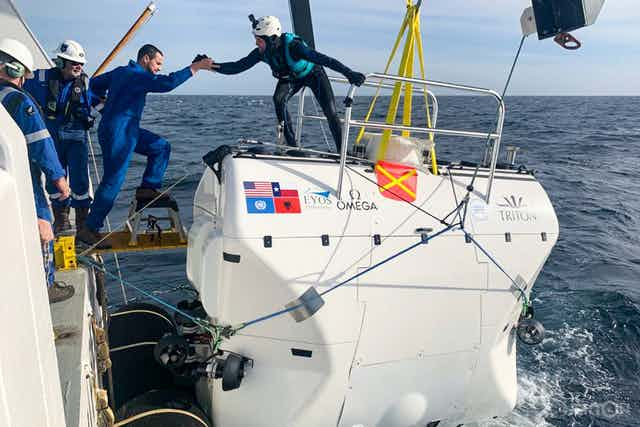Oceans cover over 70% of our “blue” planet and are vital to its health. For instance carbon moves in and out of the ocean and can be stored there for thousands of years. Oceans are also a source of food and livelihood to millions of people, and to the economies of coastal countries. They are also the largest habitable space on the planet and house many different organisms.
But there’s a great deal that scientists still don’t know about the world’s oceans.
The “deep sea” is traditionally defined as below 200m. Usually light from the sun can’t reach these depths and they are home to organisms that have special adaptations to live here. These waters are often in remote areas, and are beyond the reach of all but specialist technologies, therefore much of the deep sea remains under-explored.
Exploration is always revealing species that are new to science. Many of these could be directly important to humans, for example some contain specific compounds that may aid medicinal advances.
The Seychelles and the Maldives are now jointly launching a new deep-sea scientific mission in the Indian Ocean that is focused on seamounts – large land-forms that rise from the ocean floor but don’t reach the surface. Because of a limit in equipment and experts, there have not been any systematic biological surveys of this region at these depths before. Historically, this type of research has been near countries with better access to resources, such as those on the shores of the Atlantic and Pacific Oceans.
The mission of the “First Descent: Midnight Zone” is to understand what lives in the water, from the surface to the seabed. We also want to know how this changes from waters in the Seychelles to the Maldives.
This information will eventually be available on open access databases, building on the global knowledge of the deeper ocean for other scientists and policy makers. We hope that this information enables countries to understand how to manage their oceans better.
Equipment
Our expedition is made up of scientists from many different disciplines who are coming together to document biological, physical and chemical parameters. This will provide us with valuable baseline data which can also be used to predict life in other sites that we couldn’t explore.
The gear we will use ranges from traditional oceanographic technologies to newly developed equipment.
For example we will use a multibeam echo-sounder – a type of sonar – to visualise the shape and depth of the seamounts. Sensors and water samplers will examine water columns – imagine columns of water from the surface of the ocean to the bottom. Neuston nets – like a net between two floats – are used to sample zooplankton and microplastics in the “neuston layer”, or top few centimetres of the ocean.
The most advanced piece of technology we will use is the full depth submersible, it looks like an underwater pod that can go to extreme depths. This enables us to explore the steep slopes of the seamounts. This will allow us to film and record transects of the seabed and also take samples of specific organisms of interest with the manipulator arm. We expect to find cold water coral reefs and gardens of soft corals and sponges – all home to diverse life.
This expedition will take five weeks, operating 24 hours a day.
Exploration sites
We are exploring six seamounts that were prioritised by stakeholders – such as government ministries – from the Seychelles and Maldives.
Seamounts are interesting to explore because they are a hotspot for marine life. This is because they rise up from the seafloor and push deep, cold nutrient rich waters up around and over them to the surface. Also, because they’re hard and sediment can’t settle on the slopes and vertical surfaces, organisms can attach to them. In the deep sea the seabed is mostly rock, covered by a thick layer of sediment.
In addition to this information, by visiting locations east and west of the Central Indian Ridge, we hope to investigate whether the ridge is a potential barrier to organisms moving. This is important to help the understanding of genetic connectivity across the region. Genetic connectivity can help us understand where isolated, and therefore more vulnerable, populations of organisms are.
Useful data
Seychelles is to announce its massive project to protect 30% of their waters. Data from the expedition will help inform this process. This protection includes both no-take zones and the banning of some activities.
In the Maldives a process of marine spatial planning – ocean zoning to remove or include specific activities – has just started. Documenting life in the deep waters enables us to ground assumptions on life made at these depths, and could show areas that need future protection.
Finally some of the seamounts that we will visit are in the high seas. This area is beyond national jurisdiction and is currently receiving international attention because of a UN treaty that’s being negotiated. Shining a spotlight on seamount life could help galvanise action by the parties and the new knowledge that comes from the data collected could help future management of the region.
Sheena Talma, a key scientist working on the mission, also contributed to this article.

